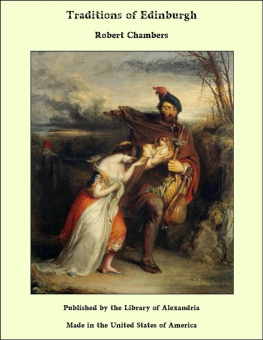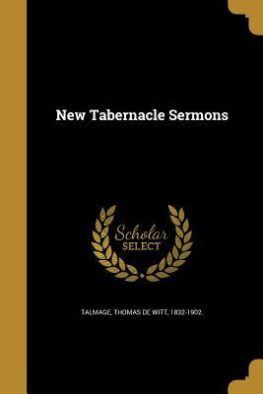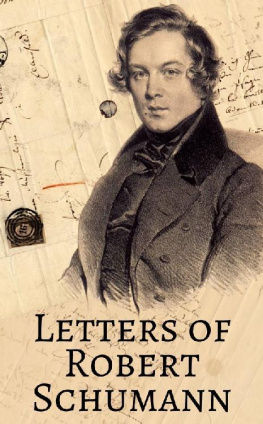INTRODUCTORY NOTICE.
1868.
I am about to do what very few could do without emotionrevise a book which I wrote forty-five years ago. This little work came out in the Augustan days of Edinburgh, when Jeffrey and Scott, Wilson and the Ettrick Shepherd, Dugald Stewart and Alison, were daily giving the productions of their minds to the public, and while yet Archibald Constable acted as the unquestioned emperor of the publishing world. I was then an insignificant person of the age of twenty; yet, destitute as I was both of means and friends, I formed the hope of writing something which would attract attention. The subject I proposed was one lying readily at hand, the romantic things connected with Old Edinburgh. If, I calculated, a first part or number could be issued, materials for others might be expected to come in, for scores of old inhabitants, even up perhaps to the very oldest, would then contribute their reminiscences.
The plan met with success. Materials almost unbounded came to me, chiefly from aged professional and mercantile gentlemen, who usually, at my first introduction to them, started at my youthful appearance, having formed the notion that none but an old person would have thought of writing such a book. A friend gave me a letter to Mr Charles Kirkpatrick Sharpe, who, I was told, knew the scandal of the time of Charles II. as well as he did the merest gossip of the day, and had much to say regarding the good society of a hundred years ago.
Looking back from the year 1868, I feel that C. K. S. has himself become, as it were, a tradition of Edinburgh. His thin effeminate figure, his voice pitched in althis attire, as he took his daily walks on Princes Street, a long blue frock-coat, black trousers, rather wide below, and sweeping over white stockings and neat shoessomething like a web of white cambric round his neck, and a brown wig coming down to his eyebrowshad long established him as what is called a character. He had recently edited a book containing many stories of diablerie, and another in which the original narrative of ultra-presbyterian church history had to bear a series of cavalier notes of the most mocking character. He had a quaint biting wit, which people bore as they would a scratch from a provoked cat. Essentially, he was good-natured, and fond of merriment. He had considerable gifts of drawing, and one caricature portrait by him, of Queen Elizabeth dancing, high and disposedly, before the Scotch ambassadors, is the delight of everybody who has seen it. In jest upon his own peculiarity of voice, he formed an address-card for himself consisting simply of the following anagram:
quasi dicitur C sharp. He was intensely aristocratic, and cared nothing for the interests of the great multitude. He complained that one never heard of any gentlefolks committing crimes nowadays, as if that were a disadvantage to them or the public. Any case of a Lady Jane stabbing a perjured lover would have delighted him. While the child of whim, Mr Sharpe was generally believed to possess respectable talents by which, with a need for exerting them, he might have achieved distinction. His ballad of the Murder of Caerlaverock, in the Minstrelsy, is a masterly production; and the concluding verses haunt one like a beautiful strain of music:
To sweet Lincludens haly cells
Fu dowie Ill repair;
There Peace wi gentle Patience dwells,
Nae deadly feuds are there.
In tears Ill wither ilka charm,
Like draps o balefu yew;
And wail the beauty that coud harm
A knight sae brave and true.
After what I had heard and read of Charles Sharpe, I called upon him at his mothers house, No. 93 Princes Street, in a somewhat excited frame of mind. His servant conducted me to the first floor, and showed me into what is generally called amongst us the back drawing-room, which I found carpeted with green cloth, and full of old family portraits, some on the walls, but many more on the floor. A small room leading off this one behind, was the place where Mr Sharpe gave audience. Its diminutive space was stuffed full of old curiosities, cases with family bijouterie, &c. One petty object was strongly indicative of the mana calling-card of Lady Charlotte Campbell, the once adored beauty, stuck into the frame of a picture. He must have kept it at that time about thirty years. On appearing, Mr Sharpe received me very cordially, telling me he had seen and been pleased with my first two numbers. Indeed, he and Sir Walter Scott had talked together of writing a book of the same kind in company, and calling it Reekiana, which plan, however, being anticipated by me, the only thing that remained for him was to cast any little matters of the kind he possessed into my care. I expressed myself duly grateful, and took my leave. The consequence was the appearance of notices regarding the eccentric Lady Anne Dick, the beautiful Susanna, Countess of Eglintoune, the Lord Justice-clerk Alva, and the Duchess of Queensberry (the Kitty of Prior), before the close of my first volume. Mr Sharpes contributions were all of them given in brief notes, and had to be written out on an enlarged scale, with what I thought a regard to literary effect as far as the telling was concerned.
By an introduction from Dr Chalmers, I visited a living lady who might be considered as belonging to the generation at the beginning of the reign of George III. Her husband, Alexander Murray, had, I believe, been Lord Norths Solicitor-general for Scotland. She herself, born before the Porteous Riot, and well remembering the Forty-five, was now within a very brief space of the age of a hundred. Although she had not married in her earlier years, her children, Mr Murray of Henderland and others, were all elderly people. I found the venerable lady seated at a window in her drawing-room in George Street, with her daughter, Miss Murray, taking the care of her which her extreme age required, and with some help from this lady, we had a conversation of about an hour. She spoke with due reverence of her mothers brother, the Lord Chief-justice Mansfield, and when I adverted to the long pamphlet against him written by Mr Andrew Stuart at the conclusion of the Douglas Cause, she said that, to her knowledge, he had never read it, such being his practice in respect of all attacks made upon him, lest they should disturb his equanimity in judgment. As the old lady was on intimate terms with Boswell, and had seen Johnson on his visit to Edinburghas she was the sister-in-law of Allan Ramsay the painter, and had lived in the most cultivated society of Scotland all her long lifethere were ample materials for conversation with her; but her small strength made this shorter and slower than I could have wished. When we came upon the poet Ramsay, she seemed to have caught new vigour from the subject: she spoke with animation of the child-parties she had attended in his house on the Castle-hill during a course of ten years before his deathan event which happened in 1757. He was charming, she said; he entered so heartily into the plays of children. He, in particular, gained their hearts by making houses for their dolls. How pleasant it was to learn that our great pastoral poet was a man who, in his private capacity, loved to sweeten the daily life of his fellow-creatures, and particularly of the young! At a warning from Miss Murray, I had to tear myself away from this delightful and never-to-be-forgotten interview.




